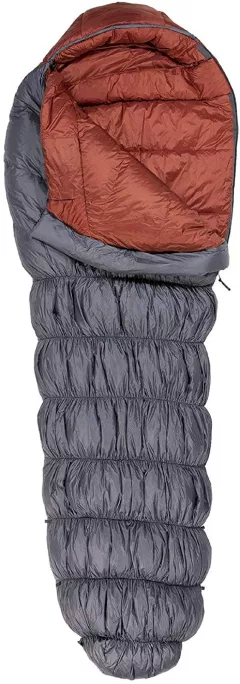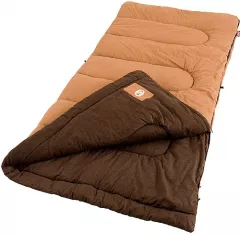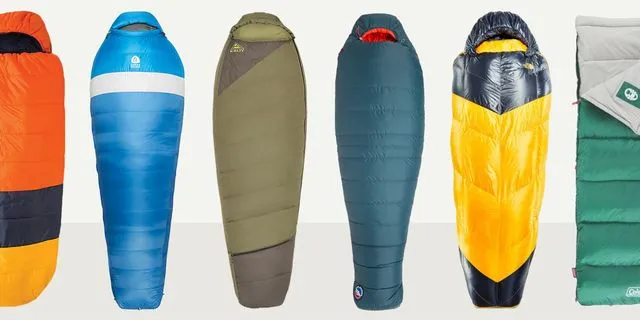The straightforward zippered blankets that many of us recall from childhood sleepovers or camping vacations are no longer commonplace sleeping bags. They are now widely recognized as critical survival gear items because to their body-hugging “mummy” patterns and insulation ratings as low as -50°F..
You can locate a modern sleeping bag to meet your specific needs, whether you’re an avid extreme sports participant or a weekend warrior.
Table of Contents
- CONSIDERATIONS
- SLEEPING BAG PRICES
- WAYS TO IMPROVE SLEEPING BAGS PERFORMANCE
- HOW TO REPURPOSE OLD SLEEPING BAGS
- Convert it into an emergency comforter or throw blanket
- Combine several sleeping bags into a sleeping pallet or child’s play area
- Create other winter gear from a used sleeping bag
- Protect your belongings in storage or during transportation
- Donate used sleeping bags to a homeless shelter or another nonprofit group
- Convert a sleeping bag into a pet bed
- Conclusion
- FAQ
| IMAGE | PRODUCT | DETAILS | ||
|---|---|---|---|---|
| Best of the Best |
Best of the Best

|
TETON Sports Fahrenheit Mammoth Queen-Size Double Sleeping Bag |
|
Check On Amazon |
| Best Bang for the Buck |
Best Bang for the Buck

|
Coleman Sleeping Bag |
|
Check On Amazon |

|
TETON Sports Regular Sleeping Bag |
|
Check On Amazon | |

|
Klymit KSB 20°F Large, Sleeping Bag |
|
Check On Amazon | |

|
Coleman Dunnock Cold Weather Adult Sleeping Bag |
|
Check On Amazon |
CONSIDERATIONS
It would help to consider some important considerations when choosing a sleeping bag. Here they are with advice on how to determine what you require.
Construction materials
Many modern sleeping bags are constructed from the same fabrics as plush blankets and winter coats.
Gore-Tex is a well-liked option, along with nylon for water resistance and goose down for insulation. Find one that employs down alternatives or other hypoallergenic materials if you have allergies.
Manufacturers occasionally mix specific hydrophobic polymers into the down to promote dryness or flame-retardant substances into the shell to increase safety.
While some sleeping bags are entirely waterproof, others should, at most, be regarded as water-resistant or quick drying. For hikers and campers, overall weight and compression are important factors.
Insulation ratings
Insulation functions differently in each sleeping bag.
Some contain numerous liners, which, when combined, provide variable degrees of insulation. Others cover a wide range of outside temperatures with a single layer of insulation. Depending on the user’s attire, some can withstand outdoor temperatures as low as 0°F.
Others are lightweight enough to offer just the right amount of insulation for overnight stays, overnight visits, or slumber parties.
We list each top contender’s insulation ratings in the product list at the top of this page.
Comfort and design
Some of our top contenders use the conventional comforter style with zippers. Others employ a “mummy” style that fits more closely to the body to add extra insulation.
Although some customers enjoy a mummy bag’s body-hugging fit, others prefer to have more room to move around in their sleeping bag.
Both designs have benefits and drawbacks, so it’s a decision you must carefully examine based on your preferred sleeping position and the conditions you will use the sleeping bag in most of the time.
SLEEPING BAG PRICES
A higher-end sleeping bag typically has stronger weatherproofing, more down-fill power, and better insulating ratings. However, a more fantastic retail price occasionally correlates with a specific manufacturer’s strong brand or market position.
While some higher-end sleeping bags function poorly in real-world situations, several more affordable sleeping bags perform on par with their more well-known competitors.
While the cost will always be a factor when picking the best sleeping bag, performance still precedes price.

WAYS TO IMPROVE SLEEPING BAGS PERFORMANCE
Sleeping bags are made to shield users from most weather conditions, including snow, rain, and dampness from the ground.
They aren’t made to deal with many other problems campers confront, like pebbles, rough terrain, and pest invasions.
Various ways to enhance the performance of sleeping bags are not complicated or expensive.
Here are some suggestions for maximizing a conventional sleeping bag’s utility.
Invest in a sleeping bags liner
Some campers pack extra blankets from home to stuff into their sleeping bags for cooler evenings.
For backpack campers or survivalists, this added weight might not be helpful.
A sleeping bag liner offers more insulation and comfort without significantly increasing the weight of the equipment. The addition of a thin liner shouldn’t impact the repacking procedure.
Buy a sleeping bag with a lower temperature rating than you might need
On a backpacking trip, a lightweight sleeping bag with a “summer” rating might be easier to transport, but it might also be freezing at night.
Suppose you are unsure of the typical nightly temperatures in the camping region. In that case, you may want to pack extra linings or bring a three-season sleeping bag suited for colder temperatures.
You will need a warmer sleeping back than if you were sleeping on the ground if you want to attempt camping without a tent and instead use a hammock.
In harsh winter weather, a three-season bag performs similarly. Unquestionably, a model with a natural winter weight can offer more warmth.
Bring an air mattress or thick camping pad.
It virtually never goes well for the user to lay a sleeping bag straight on bare ground.
One possibility is that the earth’s moisture will wick into the bag. After a few hours, the little rocks and sticks under the bag grow more and more uncomfortable.
Additionally, any opening in the zipper or the hood part allows insects to enter the bag.
Using an inflatable mattress or a thicker, waterproofed sleeping pad to create a barrier between the contaminated ground and the sleeping bag can mitigate the effects of challenging terrain.
Air out and shake out a sleeping bag between uses
Mildew and other harmful germs might develop due to too much moisture.
Sleeping bags should be wholly unzipped and hung to dry completely.
Bags should also be shaken out and brushed to get rid of any dirt, sticks, leaves, or insects that may have accumulated overnight.
Consider putting several sleeping bags into a rotation.
One summer-weight sleeping bag may be plenty for occasional campers and lovers of sleepovers, but devoted campers and backpackers should invest in various sleeping bags.
For one kind of expedition, a thin, survivalist-style sleeping bag would be adequate, while for another, a robust, winter-rated model would be preferable.
The insulating power and level of comfort of a sleeping bag might change after repeated use. After a camping trip, Always give a sleeping bag space to unwind and recover.

HOW TO REPURPOSE OLD SLEEPING BAGS
Although most sleeping bags are made to last for years before replacement, it’s not uncommon for a casual camper to have a collection of used sleeping bags in a closet or destined for the trash.
Use them again before you throw them away. A gently used sleeping bag can be recycled or utilized for various other things.
Convert it into an emergency comforter or throw blanket
Removing the zippers is optional, but a rectangle sleeping bag works well as a throw blanket for the living room or den or as a bed cover on unseasonably chilly nights. Some people might choose to stitch armholes into the sleeping bag to make a wrap similar to a Snuggie.
Combine several sleeping bags into a sleeping pallet or child’s play area
For overnight guests, some sleeping bags with left- and right-facing zippers can be zipped together to form a sleeping platform. Others can be stitched together using a serger to create a soft, secure surface for children to delightfully crawl or walk.
Create other winter gear from a used sleeping bag
A discarded sleeping bag’s shell and filler material can be turned into pillows, mittens, storage bags, and other helpful winter accessories by owners who are skilled sewers.
Protect your belongings in storage or during transportation
During a transfer, used sleeping bags can act as padding between boxes or as insulated covers for packed objects.
Donate used sleeping bags to a homeless shelter or another nonprofit group
Used sleeping bags, tents, and other camping supplies would likely be gratefully accepted by organizations that directly assist homeless people. Many charity shops and nonprofit organizations also receive used sleeping bags in fair condition.
Convert a sleeping bag into a pet bed
Although any current hardware (zipper pulls, etc.) may need to be removed, a used sleeping bag makes a beautiful complement to an existing pet bed or serves as the foundation for a new one.
An older pet can appreciate the increased insulation and padding the sleeping bag offers. Observe: You should be able to machine wash the entire bag.
Conclusion
Modern sleeping bags have come a long way from our youth’s simple, practical baggies. Several characteristics set some sleeping bags apart from others—besides price. Some of these include design (mummy vs. traditional), insulation (down vs. synthetic), weight (lightweight down to +30°F vs. heavyweight for extreme weather), and loft (how puffy it is).
But whatever your preferences may be, you can find a bag that suits your particular needs—whether you prefer a Western mountaineering expedition to the Alps or a weekend of camping at the state park with the family.
FAQ
1-The greatest all-around sleeping bag is the Snugpak Softie 9.
2-The finest inexpensive sleeping bag for festivals is the Eurohike Snooze 200.
3-The best inexpensive expedition sleeping bag is the Vango Nevis 300.
4-The greatest sleeping bag for light warmth is the Rab Neutrino 400.
Since its creation, polar expeditions have relied on the Snowy Owl, the warmest sleeping bag on the world. Our fully contoured construction keeps the 900+ fill down in the head and shoulder areas full and evenly lofted.
Semi-rectangle sleeping bags; rectangular sleeping bags; and rectangular sleeping bags.
sleeping bags in the shape of mummies.
Having two sleeping bags.
the quilts.
sleeping bags made from an elephant’s foot.
Sleeping bags without zips.
bags for women to sleep in.
Sleeping bags for season three are made for chilly fall and winter nights without frost. Perfect for people who feel the cold while they sleep and those who brave the weather to go winter camping.
Unzip the sleeping bag entirely as soon as you can, then use a brush to clear out any noticeable trash (leaves, dirt, rocks, etc.). The open bag should then be hung or draped over a clothesline or railing and let to air dry for a minimum of a day or two.
Before zipping up their sleeping bags and placing them in the original storage bags, some owners might want to lightly spray the fabric with fabric refresher. A unique sleeping bag liner, which is available separately from camping supply stores, can help maintain the bag in good shape in between usage.
In no way. When completely zippered or knotted, sleeping bags are made to trap as much air as possible. That air is warmed by the user’s natural body heat, albeit the outcome may differ. You won’t contribute as much heat if the ambient air temperature has altered your core body temperature. And a “heat sink” effect may occur if the sleeping bag is set directly on the ground. The hot air can be kept within the sleeping bag by putting a foam pad between the ground and it. The condition should be made better by additional blankets or a sleeping bag liner.

